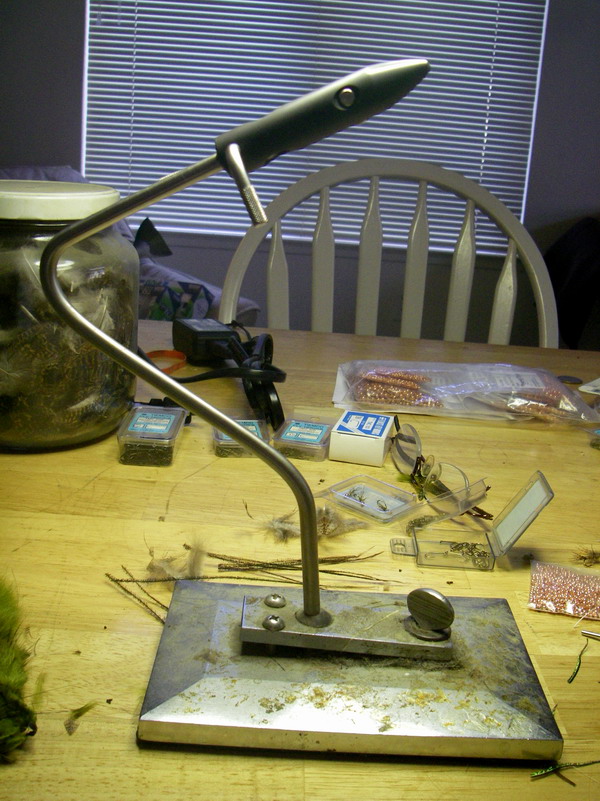 Fly Tying is one of those rare disciplines blending art and science. An endless source of frustration and pleasure, interspersed with fits of genius, artistic tantrum, and drudge.
Fly Tying is one of those rare disciplines blending art and science. An endless source of frustration and pleasure, interspersed with fits of genius, artistic tantrum, and drudge.
There are really only three types of fly tiers; Beginners, Experts, and Opinionated, and like any art form is replete with sub-schools, trends, false prophets, and is always on the brink of total revolution. New materials are always the catalyst for change, with much of the old thrown out and whatever is “new” trumpeted as the one true path.
Somewhere in all of this is the aspiring tier, surrounded by Bibles, dusty tomes, and countless magazines, usually without the materials cited by the prestigious authors, and hanging somewhere near financial insolvency, trying to keep pace.
You’ve completed the introductory and intermediate fly tying courses offered by your local club or shop, and are now left to your own devices to plod your way to your Brown and Black belts. You have an awful lot of mind numbing repetition to endure before your flies resemble those you’re using as models. There is no fast path to competency, but there are many things that you can focus on during apprenticeship to make it less onerous and more engaging.
Material Shortcomings
The material problem will always be present, half of the new fly patterns you’ll read about are “new” only because of the use of some revolutionary material, guaranteeing if you?re using magazines as inspiration, you’ll be making frequent trips to the fly shop.
New materials are a given in this craft, as synthetics slowly replace all of the exotic birds and beasts we’ve used in the past. In many cases the synthetics are much superior to the original – only Luddites and old guys with a lifetime supply to mourn their passing.
At this stage of your indoctrination you may believe tying an Adam’s without the proper materials will yield a fly less successful. Not true, all you’ve done is invent a new fly, no thunderbolt will strike you dead, no crime has been committed, and fish will eat your Adam’s minus Grizzly hackle just as fast as they’ll eat the normal pattern.
The only difference between what you’re tying and what a professional ties, is how many fish it will handle before exploding. That talent you’ll acquire as part of the mindless repetition part. Substitute freely, and throw the result in your fly box, as nothing beats the thrill of duping a fish with something you invented.
What Works, Good Design Principles
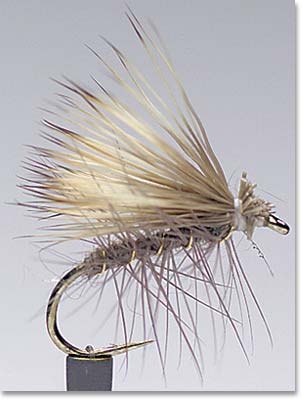 Solid construction and good design are your immediate goals. Construction is learned through understanding the limits and proportions of fly tying. Limits are inflexible and exceeding them will weaken the finished fly.
Solid construction and good design are your immediate goals. Construction is learned through understanding the limits and proportions of fly tying. Limits are inflexible and exceeding them will weaken the finished fly.
There is only a finite segment of hook shank that is flat and level, exceeding that will cause tails to point downward, or hook eyes to be filled with hackle barbules and cement. Later when fishing and the fish have a sudden weakness for Pheasant Tail nymphs, your last one can’t be threaded on the leader…that is a crime.
Proportions are similar to limits, but they are flexible. Fly components are measured by hook gape, or shank length, depending on how your instructor or favorite book taught you. Tail length can be shortened or lengthened without compromising construction, so proportions are guides, not inflexible limits.
On rare occasion the properties of a tying material will make proportion a limit. Duck Quill wings on traditional dry flies are a great example, the material is both fragile and rigid, absorbing head cement like a sponge. Once dry they can easily spin a 7X tippet like a rubber band during false casts, especially if oversized. Beautiful to look at but poorly designed for fishing.
You look at your latest handy work, an Adam’s with no Grizzly hackle and your hackle tip wings are at different heights. What do you do? You put it in your fly box. Trout’s eyes are mounted on the sides of their heads, much of their visual plane is monocular vision (only one eye can see the object), if it’s hungry your wings won’t matter.
Coming Out : Imitation versus Impressionism
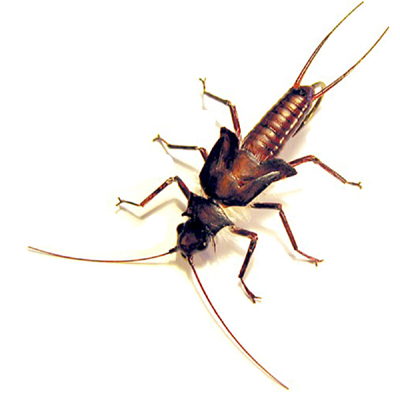 This will be your first significant test as a fly tyer, this is where you will vacillate uncontrollably, dipping your toe first in one, then the other – trying to find who and what you believe in. No author or magazine can help you, this is the test of tyer-as-artist, and likely you will see merit in both camps, but will slowly trend towards one or the other as your craft matures.
This will be your first significant test as a fly tyer, this is where you will vacillate uncontrollably, dipping your toe first in one, then the other – trying to find who and what you believe in. No author or magazine can help you, this is the test of tyer-as-artist, and likely you will see merit in both camps, but will slowly trend towards one or the other as your craft matures.
Imitation is exactly what it implies, you prefer crafting replicas of actual insects, and as a fisherman you believe them to be more effective than generalist patterns. Isn’t this the reason why you wanted to learn to tie flies, so that you could have better more exacting choices?
Real insects are hard and shiny as they wear their “skeleton” on the outside, imitation often leads to the use of synthetic or shiny materials to simulate the real bug. Compensate for the lifeless and hard materials with some that add movement or motion. The photograph is motionless, but the real bug squirms and wriggles, it is a living insect you are duplicating, not the photo.
Flies catch more than fish, flies catch fishermen too. All of us are guilty of the “..if I were a fish I would eat that” logic, which probably hinders us more than helps, as we have no idea what trout think. One thing is true, exacting imitations are pure sex, we want them bad, and the entire angling industry panders to our obsession, with our paycheck the obvious victim.
Impressionism is simulation of an insect, roughly matched to shape, size and color, but with little detail. Impressionistic flies may be general enough to represent all three aquatic food groups with a single pattern, with only the hook size changing. Other flies may acknowledge a damselfly has three paddle shaped gills as a tail with a tuft of marabou, the expression that the damsel has a more substantial tail than a mayfly, but it is not copied beyond that.
This is the fun part, where your experiences are married with the practical and the theoretical, where myth is confirmed and legend can be discarded, it’s the crucible where “your” flies are born.
Which path you prefer is inconsequential, you can fiddle with materials, you have license to alter proportions, you can make flies that resemble nothing, everything, or something – and you’ll be catching fish with all of them.
Fly Tying, the Craft is not the Art
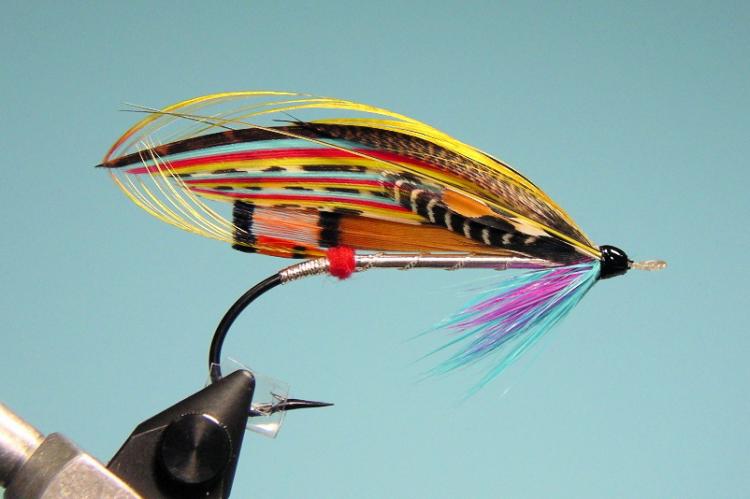 Fly tying craft is disguising a hook by imitating common fish food for use with rod and reel. Fly tying art is the rigor of perfecting these techniques to produce flies worthy of framing, or showcasing the talents of the tier, never to be used in anger.
Fly tying craft is disguising a hook by imitating common fish food for use with rod and reel. Fly tying art is the rigor of perfecting these techniques to produce flies worthy of framing, or showcasing the talents of the tier, never to be used in anger.
At times it’s tough to distinguish between the two, the lines are fluid making it difficult for an apprentice tyer to gauge progress. Much of your angling is reduced to a few trips per year, and the confirmation of your flies effectiveness will not be regular. Magazines and books are constant companions at the tier’s bench, and what you create will be compared to the photographs they contain, it’s important to distinguish art from craft, and to compare apples with apples.
A talented tier can create flies that ignore all proportion, stretch known limits, are extremely difficult to tie, and require exotic materials. It also may take them 3 or more hours to tie that fly, it represents art of the highest form, but can be confused with functional patterns by the unwary.
Putting it all together, the Art of Domestic Bliss
Every rule of fly tying has been broken by flies that are the exception. All limits shattered, all proportion thrown by the wayside, and herein lies sanctuary. The most important rule is do they work, not are they beautiful.
Fish are stupid, have poor vision, and are not vocal, they’ll never sing your praises.
You will have to tie many thousands of flies before proportion and construction are second nature. During all this time, you will evolve many theories, you will read many more, some may hold water and some may not.
Collect real bugs from your favorite streams and imitate them with the materials at hand, forget about what you don’t own, use what you have. Every fly you tie hones your construction skills, even if it never sees action.
A small coffee grinder used with a skein of yellow, red, and blue yarn, can yield every color in the rainbow, chop the segments shorter than an inch, and use the Artist’s Color Wheel to make your fur colors. Fly tying is actually many disciplines, some not related to fishing at all.
Test materials and flies in your bathtub, learn what adds life and motion, and what makes your fly ride upside down. You will find that physics and proportion are tied together, you can take license with proportion knowing what the physical change will be in its aerodynamic or fishing qualities.
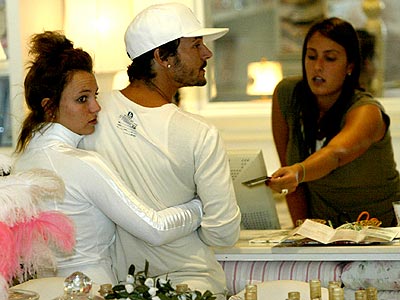 Exploit the materials available to you, leverage your friends. Do you hunt ducks? Does your neighbor? More importantly, does your neighbor notice the bald spot on his Airedale? Be wary, as 20 lbs of fresh killed deer hide will have to be treated immediately, right after you resuscitate your wife…
Exploit the materials available to you, leverage your friends. Do you hunt ducks? Does your neighbor? More importantly, does your neighbor notice the bald spot on his Airedale? Be wary, as 20 lbs of fresh killed deer hide will have to be treated immediately, right after you resuscitate your wife…
Fly tying is a mess maker hobby, filled with odiferous and objectionable items. You will need special storage arrangements to retain domestic bliss. Rotting flesh and moth infestations will be unpopular, seal everything separately to minimize infestation and odor, and use incense cedar rather than mothballs, as moth crystals smell equally bad. Open drawers mean your dog is eating your purple buck tail, or your child is reaching for the porcupine. Be alert that everyone in the household may not share your passion.
You need to address the storage issue almost immediately, and with a permanent furniture purchase. An old vanity table and a chest of drawers will work, both are garage sale fodder, tear the top off the desk and build a new larger work surface. Line both with incense cedar slats from the hardware store. To be allowed into your house, refinish both, as a $25 garage sale purchase can turn into something much better looking if sanded and finished properly.
After all this, you will be confronted by many critics that will find fault with your finest work. Most will have their paws in your fly box to assist you in “lightening” it, but the real critic is the trout, stay focused and please the fish first. Remember you started this bestial trek thinking you would catch more fish, and you are much further along than you think.
Technorati Tags: fly tying, fly tying impressionism, realistic imitation

Come on now Kieth, you know as well as I do a #10 olive leech tied on a Tiemco 200r is really the only fly you’ll ever need to catch a fish. 😉
Excellent article. I had no idea you computer geeks could write so well. I wish I could give you a fishing report but all I’ve done this summer is be stuck in the ECC wishing I was fishing.
No problem, Gene – you handle the Red Iron, I’ll handle the Sharp Iron – at least until you’re off shift..
KB-
Terrific article. You’re a very talented guy. I look forward to more from your keyboard as well as the vice.
Great article about fly tying, sure. But where’s the bikini photo? Where’s the traffic-exploding, “hinting at adult themes” headline??
Good, basic information about fly fishing? I’m disappointed. Deeply disappointed…